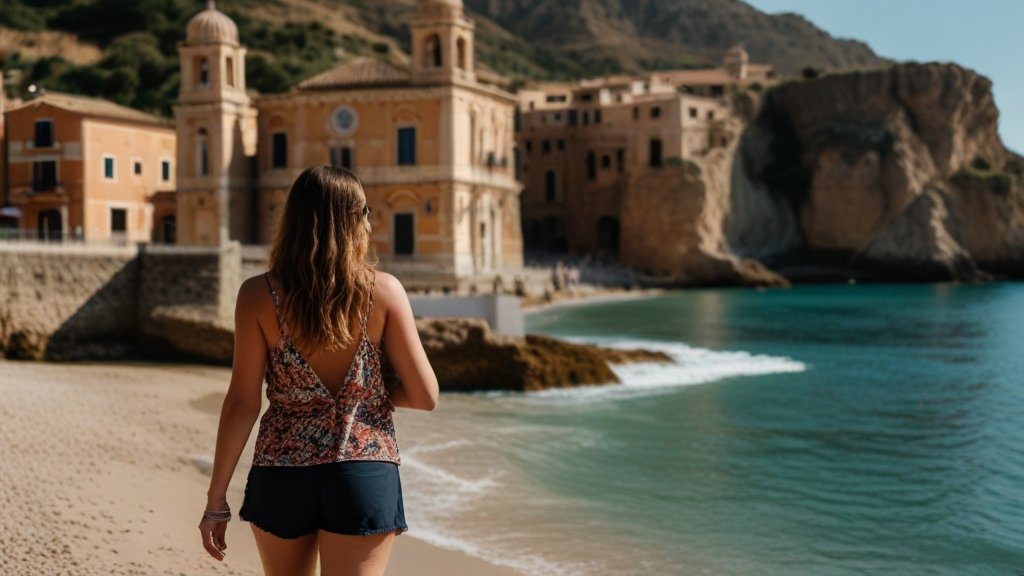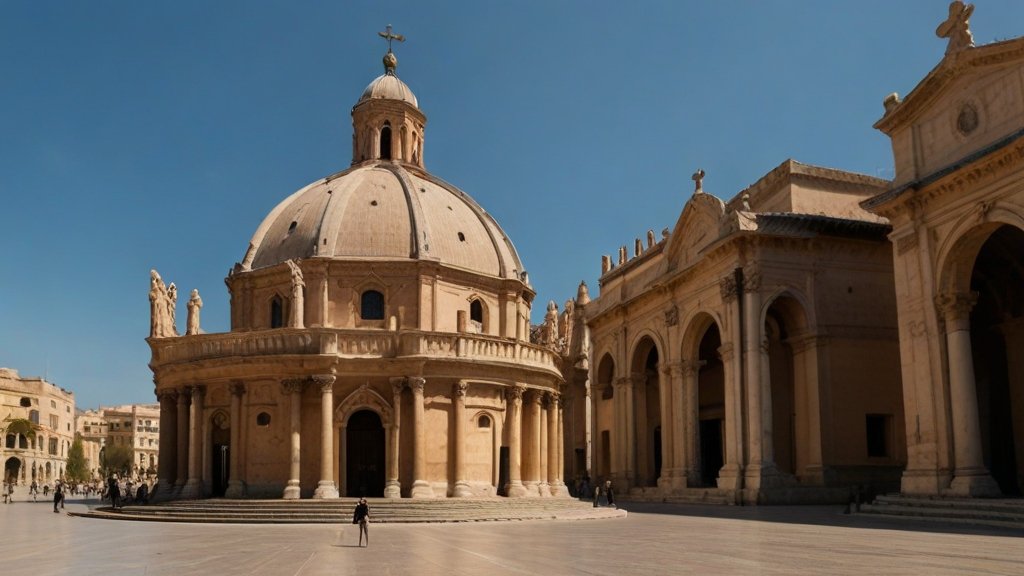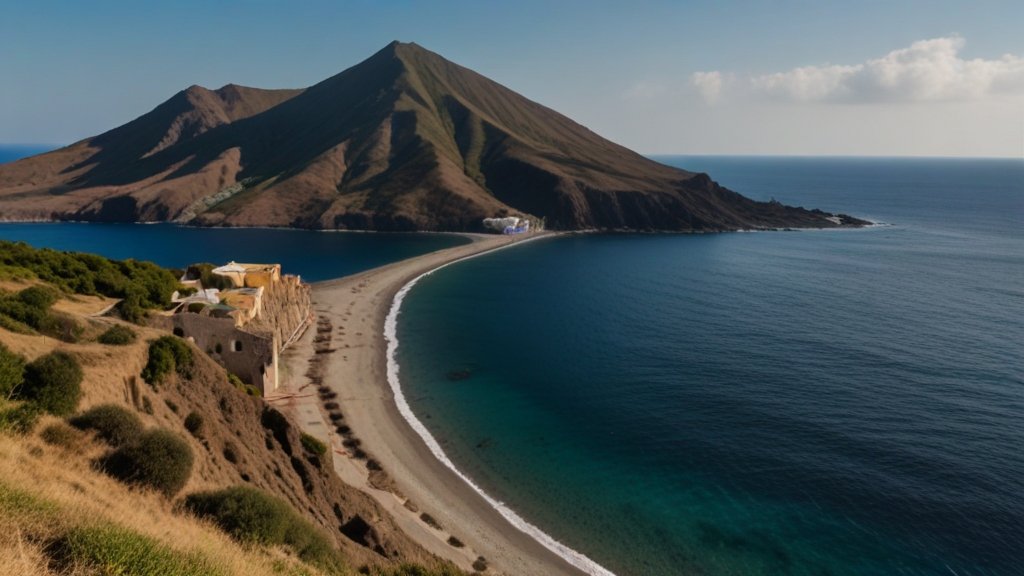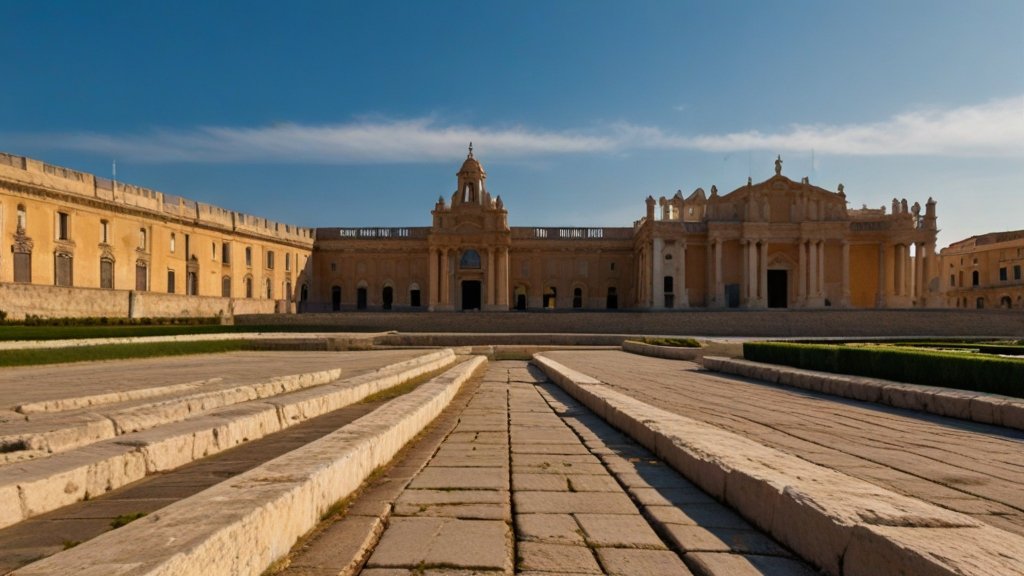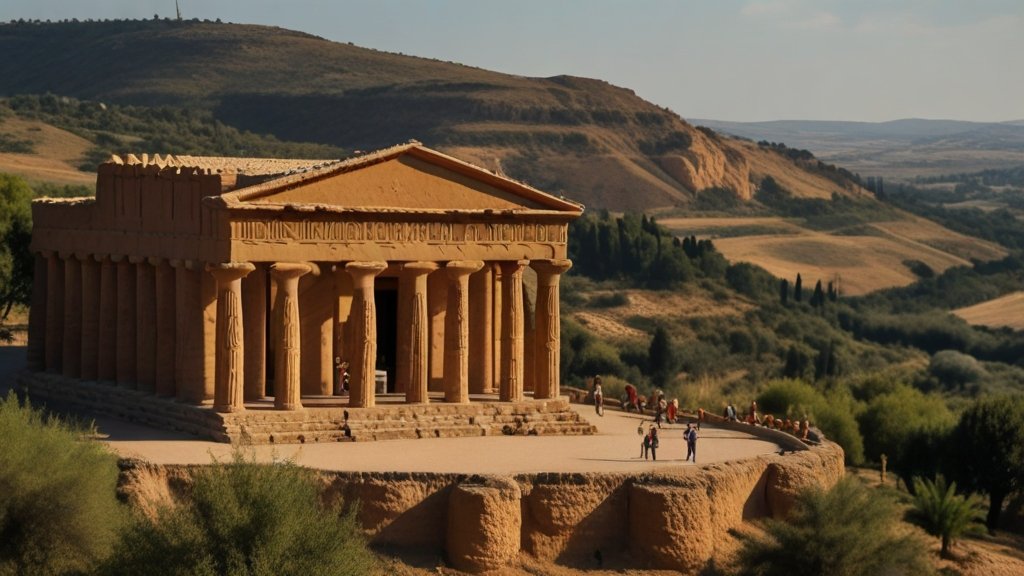Uncover the beauty of Sicily with our 10-day itinerary.
Welcome to the sun-kissed shores of Sicily, where ancient ruins whisper secrets, azure waters beckon, and culinary delights tantalize your taste buds. This 10 Days Sicily Itinerary promises an intoxicating blend of history, natural beauty, and unforgettable experiences.
Buckle up as we traverse this Mediterranean gem, leaving footprints in the sands of time.
Key Takeaways magic of Sicily with our handpicked 10-day itinerary
| 1. | Explore Palermo: Dive into the chaotic charm of Palermo, where Byzantine mosaics and bustling markets collide. |
|---|---|
| 2. | Volcanic Thrills: Witness Stromboli’s fiery eruptions and hike Mount Etna—the ultimate adrenaline rush. |
| 3. | Baroque Beauties: Noto, Modica, and Ragusa—these Baroque towns will steal your heart. |
| 4. | Valley of the Temples: Agrigento’s ancient Greek ruins are a testament to Sicily’s storied past. |
| 5. | Zingaro Bliss: Unwind in the Zingaro Nature Reserve, where cliffs meet crystalline waters. |
Day-by-Day Itinerary
Day 1-2: Palermo—Where Past Meets Present
Palermo, a city with a thousand years of history, beckons travelers with its Arab-Norman architecture, vibrant neighborhoods, and a culinary scene that dances on the taste buds. Let’s delve into the heart of this captivating Sicilian gem.
1. A Brief Overview
- Location: Palermo graces the northern coast of the Italian island of Sicily. Nestled in the Conca d’Oro, a fertile plain encircled by hills, it gazes out toward the Tyrrhenian Sea.
- Scenery: Monte Pellegrino stands sentinel to the north, adding dramatic flair. Hills stretch toward the Madonie mountains, creating a picturesque backdrop.
2. Historical Layers
Phoenician Roots
- Founded in 734 BC by the Phoenicians, Palermo was known as Sis (meaning “flower”). These seafaring traders left their mark on the city’s DNA.
Carthaginian and Greek Influence
- Palermo became a Carthaginian possession, and two Greek colonies merged into Panormos.
- The Carthaginians stamped this name on their coins after the 5th century BC.
Roman Era
- As Panormus, the city thrived under the Roman Republic and Empire for over a millennium.
Arab Rule and Balarm
- From 831 to 1072, Palermo was under Arab rule during the Emirate of Sicily. It became the capital of Sicily for the first time.
- Known as Balarm during this period, it absorbed Arabic influences into its architecture, culture, and cuisine.
Norman Conquest and the Kingdom of Sicily
- The Norman conquest transformed Palermo into the capital of the Kingdom of Sicily (1130–1816).
- Its golden age saw the fusion of Norman, Arab, and Byzantine styles, resulting in the iconic Arab-Norman architecture seen today.
3. Must-See Attractions
Teatro Massimo
- Italy’s largest opera house, the Teatro Massimo, is a grand stage for music and drama.
Cappella Palatina
- Step into the Cappella Palatina, a jewel of Arab-Norman art within the Palazzo dei Normanni.
Zisa and Cathedral
- Explore the Zisa, a Moorish palace, and marvel at the Cathedral with its mix of architectural influences.
Quattro Canti and Martorana Church
- Wander through Quattro Canti, where four Baroque facades converge.
- Admire the Church of Martorana, adorned with glittering mosaics.
Food and Markets
- Dive into Palermo’s culinary scene: arancini, cannoli, and panelle await.
- Stroll through the bustling markets like Vucciria and savor the flavors.
4. Vibrant Neighborhoods
- Kalsa: A maze of narrow streets, home to art galleries and hidden courtyards.
- La Vucciria: A lively quarter where street food reigns supreme.
- Mondello: Escape to this beachside haven, just a short drive from the city.
As you sip a Sicilian wine and watch the sun dip behind Monte Pellegrino, you’ll understand why Palermo leaves an indelible mark on every traveler’s soul. 🌅🇮🇹
Day 3: Stromboli—Fire and Fury
Stromboli, the “lighthouse of the Mediterranean,” emerges from the Tyrrhenian Sea like a sentinel guarding Sicily’s northern coast. This small island, part of the Aeolian archipelago, boasts a fiery secret—a relentless, active volcano that has captivated travelers for centuries.
1. A Volcanic Symphony
- Mount Stromboli: Rising just 3,031 feet above sea level, this volcanic giant has been spewing fountains of lava almost continuously for nearly 2,500 years. Its fiery glow earned it the nickname “lighthouse.”
- Uninhabited Sister: Strombolicchio, its uninhabited sister island, stands nearby, a rugged counterpart to Stromboli’s volcanic drama.
2. Geological Drama
Phoenician Roots and Greek Influence
- Founded by the Phoenicians in 734 BC, Stromboli was known as Sis (meaning “flower”).
- The Greeks merged two colonies into Panormos, leaving their mark on the island’s name and history.
Arab-Norman Heritage
- Arab rule during the Emirate of Sicily (831–1072) infused Stromboli with cultural richness.
- Balarm, as it was called, absorbed Arabic influences into its architecture, culture, and cuisine.
- The Norman conquest transformed it into the capital of the Kingdom of Sicily.
3. Volcanic Spectacle
Lava Fireworks
- Every summer, boatloads of visitors arrive, drawn by gleaming black-sand beaches.
- At sunset, up to 500 travelers trek to Stromboli’s summit, witnessing lava fireworks against the night sky.
Recent Eruptions
- In 2019, an unusually violent eruption caused tragedy. A hiker lost their life, and several others were injured.
- Stromboli’s volcano remains in a constant state of mild activity, occasionally punctuated by larger, more violent eruptions.
4. Safety and Risk
- Volcano Tourism: A risky business, as evident from the 2019 eruption at New Zealand’s Whakaari/White Island.
- Safety Measures: Following Stromboli’s deadly eruptions, access above 950 feet—about one-third of its elevation—is prohibited.
5. Exploring Stromboli
- Boat Tours: Local outfitters offer 360-degree views of the volcanic island.
- Black-Sand Beaches: Wander the shores, where lava meets the sea.
- Sciara del Fuoco: Witness the pyroclastic flow down this steep channel, where molten lava rushes to the sea.
As you stand on its shores, feel the pulse of Earth’s inner fire, and let the volcanic symphony resonate within you. 🌋🌅🇮🇹.
Day 4-5: Taormina—The Pearl of Sicily

Taormina, where pastel-colored houses cling to cliffs, ancient churches whisper tales of centuries gone by, and panoramic views stretch across the shimmering Ionian Sea and majestic Mount Etna. This enchanting town, perched high above the waves, invites you to savor the authentic “dolce vita” atmosphere. Let’s explore the magic of Taormina.
1. A Brief Overview
- Location: Taormina graces the east coast of Sicily, nestled in the embrace of the Metropolitan City of Messina.
- Tourist Magnet: Since the 19th century, Taormina has been a magnet for travelers, drawn by its beauty and rich history.
2. A Blend of Cultures
- Greek Roots: Taormina’s origins trace back to ancient times. The Greeks left their mark here, and remnants of their civilization still echo through the streets.
- Roman Influence: The Romans followed, leaving behind an ancient theater that stands as one of Italy’s most well-preserved gems.
3. Things to Do in Taormina
Discover Isola Bella
- Isola Bella, meaning “beautiful island,” is a stunning peninsula and nature reserve.
- Connected to the mainland beach by a thin strip of sand, Isola Bella invites you to spend an afternoon by the water.
- Tip: Walk across shallow water (at low tide) to reach the peninsula or use the Taormina–Mazzarò cable car (if it’s running).
Facilities and Activities at Isola Bella
- Swimming: The crystal-clear water around Isola Bella is perfect for a refreshing swim.
- Beach: The beach is a mix of sand and stones, so consider bringing water shoes.
- Sunbathing: Rent a daybed at one of the beach clubs and soak up the sun.
- Massage: Strolling massage therapists offer relaxation by the sea.
- Museum: Explore the museum in the house on the hill (check opening times).
Belvedere di Via Pirandello
- From this viewpoint, enjoy an excellent view of Isola Bella and the surrounding bay.
- Walk down the steps to the beach for an even closer encounter with the sea.
Other Nearby Beaches
- Naxos Beach and Mazzarò Beach (near the cable car) are equally lovely.
4. Taormina’s Authentic Charm
- Car-Free Center: Stroll the narrow alleyways, discover cute cafes, and browse Sicilian ceramic shops.
- Views Everywhere: Taormina’s clifftop location ensures stunning vistas at every turn.
- Affordable Museums: Despite being one of the more expensive destinations in Sicily, many museums and historic landmarks offer a half-price deal for Europeans under 25.
As you sip espresso in a sun-drenched piazza, you’ll feel the heartbeat of this timeless Sicilian haven. 🌅🇮🇹.
Day 6-7: Syracuse and Baroque Treasures
Syracuse, one of the oldest and most captivating cities in Sicily, invites you to explore its rich history, culture, and art. Located on the eastern coast of the island, Syracuse weaves together Greek, Roman, Byzantine, Arab, and Norman influences into a mesmerizing tapestry. Let’s embark on a journey through time and discover the treasures of this remarkable city.
1. Ancient Origins
- Greek Colonists: Syracuse’s story begins in the 8th century BC, when Greek colonists from Corinth founded the city. Its strategic position and powerful naval fleet propelled it to prominence.
- Roman Conquest: In the 3rd century BC, the Romans conquered Syracuse, expanding it into an even grander and more monumental city.
2. Must-See Attractions
Archaeological Park of Neapolis
- Greek Theater: Marvel at the ancient Greek Theater, where dramatic performances once echoed against the limestone cliffs.
- Roman Amphitheater: Explore the well-preserved Roman Amphitheater, where gladiators once battled.
- Ear of Dionysius: Stand in awe of the Ear of Dionysius, a limestone cave with remarkable acoustics.
- Necropolis: Wander through the ancient burial grounds, where history whispers from the tombs.
Island of Ortigia
- Historic Heart: Ortigia Island is the soul of Syracuse. Stroll through its narrow streets and discover hidden gems.
- Syracuse Cathedral: Admire the Syracuse Cathedral, an architectural masterpiece built atop the remains of a Greek temple.
- Fountain of Artemis: Pause by the elegant Fountain of Artemis, a symbol of the city’s ancient past.
- Maniace Castle: Explore the imposing Maniace Castle, a fortress guarding the harbor.
Paolo Orsi Regional Archaeological Museum
- Treasure Trove: Immerse yourself in Sicily’s history through countless archaeological finds.
- Venus of Morgantina: Admire the famous Venus of Morgantina, a captivating sculpture.
- Opening Hours: The museum welcomes visitors from Tuesday to Sunday, 9:00 am to 6:00 pm.
Aretusa Spring
- Mythical Waters: Aretusa Spring, located on Ortigia Island, is surrounded by papyrus plants. Legends and myths intertwine here.
Fontane Bianche Beach
- Beach Bliss: Relax on the fine white sands of Fontane Bianche Beach.
- Crystal-Clear Waters: Swim in the turquoise sea and enjoy water sports like windsurfing and kitesurfing.
Ortigia Market
- Sensory Delights: Explore Ortigia Market, where Sicilian flavors and aromas come alive.
- Culinary Art: Sample traditional and innovative Sicilian cuisine.
3. Baroque Beauty
- Church of San Giovanni Battista: Ragusa boasts Baroque treasures, including this church.
- Palazzo Cosentini: Admire the ornate Palazzo Cosentini in Ragusa.
- Cathedral of San Giorgio and San Pietro: Modica’s Baroque cathedrals are architectural marvels.
- Cathedral and Palazzo Nicolaci: Noto’s Baroque gems include the cathedral and Palazzo Nicolaci.
- Steps of Santa Maria del Monte: Caltagirone’s ceramic-decorated staircase is a sight to behold.
Let the echoes of civilizations guide you through this captivating city. 🌟🇮🇹.
Day 8-9: Agrigento and the Valley of the Temples
The Valley of the Temples (Valle dei Templi) in Agrigento, Sicily, is a mesmerizing testament to ancient classical culture. Nestled in an enchanted valley adorned with flowering almond trees, this UNESCO World Heritage Site boasts the most impressive ensemble of Hellenic architecture on the island. Let’s explore the rich history and architectural marvels of this extraordinary site.
1. Rediscovering Akragas
- The rediscovery of Akragas (the ancient name for Agrigento) began in the late 18th century when European travelers ventured into Sicily. What they found was an unexpected treasure trove of art and archaeology.
- The Valley of the Temples encompasses not only the temples of the gods but also the necropolis area and the extra-moenia sanctuaries.
2. Temples and Treasures
Temple of Concordia
- Built around the 5th century BC, the Temple of Concordia stands along the Via Sacra and is the best-preserved temple in the valley.
- Its name comes from a Latin inscription found nearby. In front of the temple, you’ll find the Statue of Icarus, a gift from the Polish sculptor Igor Mitoraj, depicting the fall of the mythological figure who flew too close to the sun.
Temple of Olympian Zeus
- Erected to honor the god Zeus after the 480 BC victory of the Agrigentines over the Carthaginians.
- The temple once housed gigantic statues called Telamones, with human features.
Temple of Heracles
- The oldest temple, dedicated to the hero Hercules, venerated by the Akragantines.
- Only eight columns remain of the original 38 due to war and earthquakes.
Temple of Aesculapius
- Located outside the ancient city walls, it served as a place of pilgrimage for the sick seeking healing.
- The temple walls bore inscriptions from the cured.
Tomb of Theron
- An imposing pyramid-shaped tufa stone monument near the Porta Aurea (Golden Gate).
- Erected to commemorate those who died in the Second Punic War.
Temple of Vulcan
- Dating back to the 5th century, its ruins suggest an imposing structure.
Temple of Juno
- Spectacularly perched on the eastern summit of the magical hill.
- Conventional name due to a misinterpretation of a Latin inscription—it is not related to the goddess Juno.
3. Baroque Beauty in Agrigento
- Agrigento’s Baroque treasures include the Church of San Giovanni Battista and the ornate Palazzo Cosentini.
- The Cathedral of San Giorgio and San Pietro in Modica and the Cathedral and Palazzo Nicolaci in Noto are architectural marvels.
Let the whispers of millennia guide you through this awe-inspiring site—a true marvel of human achievement. 🏛️🌟🇮🇹
Day 10: Zingaro Nature Reserve—Where Land Meets Sea
Zingaro Nature Reserve (Riserva dello Zingaro) is a Sicilian gem that epitomizes the untouched beauty of the Mediterranean. Nestled between the towns of San Vito Lo Capo and Castellammare del Golfo, this coastal reserve stretches along the Gulf of Castellammare, offering a pristine landscape where sea and nature harmonize in perfect symphony.
1. A Natural Pearl
- First Sicilian Reserve: Established in 1981, the Zingaro Reserve was the first protected nature reserve on the island.
- Size: Covering over 1,500 hectares, its coastal strip extends for about 7 kilometers.
2. The Untouched Coastline
- Human Harmony: The relationship with the sea here remains unchanged over centuries, if not millennia. There are minimal human interventions, except for a few rustic buildings.
- No Roads, No Cars: Within the reserve, there’s no coast road, no cars, and no noise—only the soothing sounds of wind and waves.
- Petition for Preservation: The reserve owes its existence to the determination of thousands of citizens who signed a petition, preventing the construction of a road connecting Scopello directly to San Vito Lo Capo.
3. Coastal Wonders
- Enchanting Coves: As you walk the seven-kilometer coastal path, a continuous array of wonders unfolds. Discover enchanting blue coves like Cala Tonnarella dell’Uzzo, Cala Marinella, Cala Berretta, Cala della Disa, Cala del Varo, and Cala Capreria.
- Smooth Pebbles and Rocky Outcrops: The coastline alternates between smooth white pebbles and rugged rock formations, creating a visual feast.
4. Hiking and Exploration
- Endless Surprises: Returning to the Zingaro Reserve year after year reveals new views and hidden details. Each visit unveils fresh surprises.
- Central Trail Views: Don’t miss the views from the reserve’s central trail—a panorama unlike any other in the world.
- Bosco di Scardina and Borgo Cusenza: Explore the timeless atmosphere of the Bosco di Scardina and the intact Borgo Cusenza, where echoes of shepherds and peasant farmers seem to linger.
- High Path Challenge: For avid hikers, the high path winds through Aleppo pines and Mediterranean scrub, rewarding with breathtaking vistas.
5. A Coastal Paradise
- Swimming Bliss: The Zingaro Reserve equally delights those who seek the unique experience of swimming in crystal-clear waters. Dive into perfect-temperature seas, explore the seabed with a mask, or bask in the warm sun on tiny, untamed beaches.
- Flora and Fauna: Amid the rich flora and fauna, you’ll feel at home. Foxes and seagulls share this earthly paradise with you.
The Zingaro Nature Reserve—a sanctuary where humans seem almost superfluous, and nature reigns supreme. 🌊🌿🇮🇹
Frequently Asked Questions (FAQs) for 10 Days Sicily Itinerary
| Question | Answer |
|---|---|
| 1. Is 10 days enough for a Sicily trip? | Yes, 10 days allows you to explore the highlights, but longer stays are even better. |
| 2. What’s the best time to visit Sicily? | Spring (April-May) and fall (September-October) offer pleasant weather and fewer crowds. |
| 3. How should I structure my 10-day Sicily itinerary? | Consider Palermo, Taormina, Syracuse, Agrigento, and Zingaro Reserve. |
| 4. Should I rent a car in Sicily? | Yes, a car provides flexibility to explore remote areas. |
| 5. What’s the language spoken in Sicily? | Italian, but some locals also speak Sicilian dialects. |
| 6. Can I visit Mount Etna during this itinerary? | Yes, allocate a day for Mount Etna exploration. |
| 7. Are there direct flights to Sicily? | Yes, Palermo and Catania have international airports. |
| 8. What’s the food like in Sicily? | Expect delicious seafood, arancini, cannoli, and more. |
| 9. Is Sicily safe for solo travelers? | Generally safe, but take usual precautions. |
| 10. Are credit cards widely accepted? | Yes, but cash is still useful, especially in smaller towns. |
| 11. Can I swim in Sicily in October? | Yes, the sea is still warm in early October. |
| 12. Should I book accommodations in advance? | Recommended, especially during peak seasons. |
| 13. Is Sicily expensive? | It’s moderately priced compared to other European destinations. |
| 14. Can I visit the Aeolian Islands from Sicily? | Yes, consider a day trip or overnight stay. |
| 15. What’s the dress code for visiting temples? | Modest attire—cover shoulders and knees. |
| 16. Can I hike in Zingaro Nature Reserve? | Absolutely! The trails offer stunning views. |
| 17. Is public transportation reliable? | It’s decent, but a car is more convenient. |
| 18. Can I see Greek ruins in Agrigento? | Yes, the Valley of the Temples is a must-visit. |
| 19. Are there any local festivals during my trip? | Check local calendars for events and festivals. |
| 20. What’s the best gelato flavor in Sicily? | Pistachio—hands down! |
Feel free to mix and match these FAQs to create your perfect Sicily itinerary! 🌞🇮🇹
Sicily Pre-Trip Checklist: Essential Items for Your Adventure
Before embarking on your Sicilian adventure, ensure you’re well-prepared with this comprehensive pre-trip checklist. Whether you’re exploring ancient ruins, hiking rugged trails, or lounging on pristine beaches, these items will keep you comfortable and ready for anything. Estimated costs are provided as a reference.
Clothing (All Seasons)
- Light Layers:
- T-shirts
- Long-sleeve shirts
- Lightweight sweaters
- Cardigans
- Bottoms:
- Shorts
- Pants (for cooler evenings)
- Skirts or dresses (for warmer months)
- Footwear:
- Comfortable walking shoes
- Sandals
- Hiking boots (if exploring trails)
- Swimwear:
- Bikini or swimsuit
- Beach cover-up
- Outerwear:
- Lightweight jacket or windbreaker
- Rainproof jacket (especially in fall)
- Accessories:
- Sunhat
- Sunglasses
- Scarf (for chilly evenings)
Additional Miscellaneous Items
- Travel Essentials:
- Passport and copies
- Travel insurance
- Medications and prescriptions
- Electronics:
- Universal travel adapter
- Camera or smartphone for capturing memories
- Toiletries:
- Sunscreen
- Insect repellent
- Basic toiletries (shampoo, soap, toothbrush, etc.)
- Reusable Water Bottle:
- Stay hydrated during your adventures.
Hiking Items (If Exploring Trails)
- Daypack or Backpack:
- For carrying essentials during hikes.
- Hiking Gear:
- Lightweight hiking pants
- Moisture-wicking socks
- Hat or cap
- Trekking poles (optional)
- First Aid Kit:
- Bandages, antiseptic, pain relievers
Estimated Costs (Per Person)
- Flights: Varies based on departure location.
- Accommodation: Budget options start at $50 per night; mid-range hotels around $100 per night.
- Food: Budget $20-30 per day for meals.
- Activities: Entrance fees to attractions range from $5 to $15.
- Transportation: Car rental costs vary; public transportation is affordable.
Remember to adjust your packing list based on the season and your personal preferences. Sicily awaits—buon viaggio! 🌞🇮🇹
Estimated Costs ( for reference )
| Category | Estimated Cost (per person) |
|---|---|
| Transportation | $500 (flights, ferries, car rental) |
| Accommodation | $800 (mid-range hotels and B&Bs) |
| Food | $400 (delicious Sicilian cuisine) |
| Activities | $300 (entrance fees, tours, excursions) |
| Total | $2000 |
Sicily Unveiled: A 10-Day Odyssey of Sun, Sea, and History
🌟 Buongiorno! 🌟
As our journey through Sicily draws to a close, let’s pause and savor the memories we’ve woven into our hearts. From the bustling streets of Palermo to the ancient stones of Agrigento, Sicily has whispered its tales of conquests, love, and resilience.
The Sun-Kissed Highlights
- Palermo: Where Byzantine mosaics meet vibrant markets, leaving an indelible mark.
- Stromboli: The fiery sentinel of the Aeolian Islands, painting the night sky with lava.
- Taormina: Perched above the Ionian Sea, where ancient theaters and granita await.
- Syracuse: A UNESCO World Heritage Site, where echoes of Greeks and Romans linger.
- Agrigento: The Valley of the Temples, where gods once walked among mortals.
- Zingaro Reserve: Untamed beauty, where land kisses sea in a coastal embrace.
Our Call to Action
📸 Capture the Moment: Share your Sicilian snapshots with fellow wanderers. Let the world taste the flavors of arancini and feel the warmth of the Mediterranean sun.
🌐 Spread the Magic: Share this article with fellow dreamers. Let them discover Sicily’s hidden gems and plan their own odyssey.
🗣️ Join the Conversation: Leave a comment below. Tell us about your favorite Sicilian gelato flavor or the temple that stole your heart.
💌 Subscribe: Join our newsletter for more travel inspiration. Sicily is just the beginning—more adventures await!
As the sun dips behind Monte Pellegrino, remember that Sicily isn’t just a place; it’s a feeling—a timeless embrace that lingers long after you’ve left its shores.
Arrivederci, Sicilia! 🌅🇮🇹…

